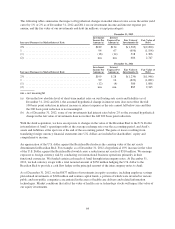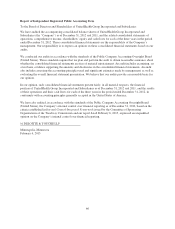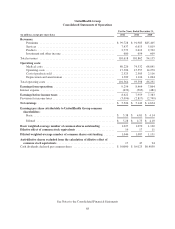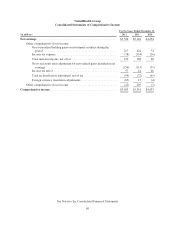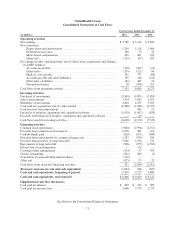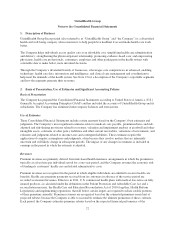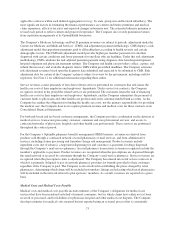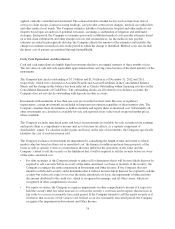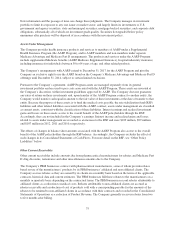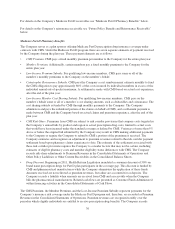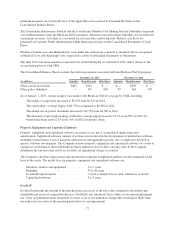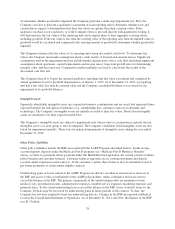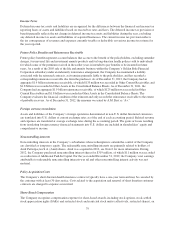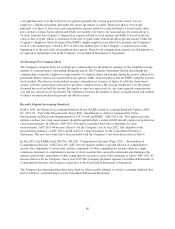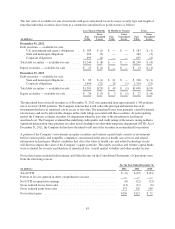United Healthcare 2012 Annual Report Download - page 76
Download and view the complete annual report
Please find page 76 of the 2012 United Healthcare annual report below. You can navigate through the pages in the report by either clicking on the pages listed below, or by using the keyword search tool below to find specific information within the annual report.applied, centrally controlled and automated. The actuarial models consider factors such as time from date of
service to claim receipt, claim processing backlogs, care provider contract rate changes, medical care utilization
and other medical cost trends. The Company estimates liabilities for physician, hospital and other medical cost
disputes based upon an analysis of potential outcomes, assuming a combination of litigation and settlement
strategies. Each period, the Company re-examines previously established medical costs payable estimates based
on actual claim submissions and other changes in facts and circumstances. As the medical costs payable
estimates recorded in prior periods develop, the Company adjusts the amount of the estimates and includes the
changes in estimates in medical costs in the period in which the change is identified. Medical costs also include
the direct cost of patient care rendered through OptumHealth.
Cash, Cash Equivalents and Investments
Cash and cash equivalents are highly liquid investments that have an original maturity of three months or less.
The fair value of cash and cash equivalents approximates their carrying value because of the short maturity of the
instruments.
The Company had checks outstanding of $1.3 billion and $1.5 billion as of December 31, 2012 and 2011,
respectively, which were classified as Accounts Payable and Accrued Liabilities in the Consolidated Balance
Sheets and the change in this balance has been reflected as Checks Outstanding within financing activities in the
Consolidated Statements of Cash Flows. The outstanding checks are all related to zero balance accounts; the
Company does not net checks outstanding with deposits in other accounts.
Investments with maturities of less than one year are classified as short-term. Because of regulatory
requirements, certain investments are included in long-term investments regardless of their maturity date. The
Company classifies these investments as held-to-maturity and reports them at amortized cost. Substantially all
other investments are classified as available-for-sale and reported at fair value based on quoted market prices,
where available.
The Company excludes unrealized gains and losses on investments in available-for-sale securities from earnings
and reports them as comprehensive income and, net of income tax effects, as a separate component of
shareholders’ equity. To calculate realized gains and losses on the sale of investments, the Company specifically
identifies the cost of each investment sold.
The Company evaluates an investment for impairment by considering the length of time and extent to which
market value has been less than cost or amortized cost, the financial condition and near-term prospects of the
issuer as well as specific events or circumstances that may influence the operations of the issuer and the
Company’s intent to sell the security or the likelihood that it will be required to sell the security before recovery
of the entire amortized cost.
• For debt securities, if the Company intends to either sell or determines that it will be more likely than not be
required to sell a security before recovery of the entire amortized cost basis or maturity of the security, the
Company recognizes the entire impairment in Investment and Other Income. If the Company does not
intend to sell the debt security and it determines that it will not be more likely than not be required to sell the
security but it does not expect to recover the entire amortized cost basis, the impairment is bifurcated into
the amount attributed to the credit loss, which is recognized in earnings, and all other causes, which are
recognized in other comprehensive income.
• For equity securities, the Company recognizes impairments in other comprehensive income if it expects to
hold the security until fair value increases to at least the security’s cost basis and it expects that increase in
fair value to occur in a reasonably forecasted period. If the Company intends to sell the equity security or if
it believes that recovery of fair value to cost will not occur in a reasonably forecasted period, the Company
recognizes the impairment in Investment and Other Income.
74


